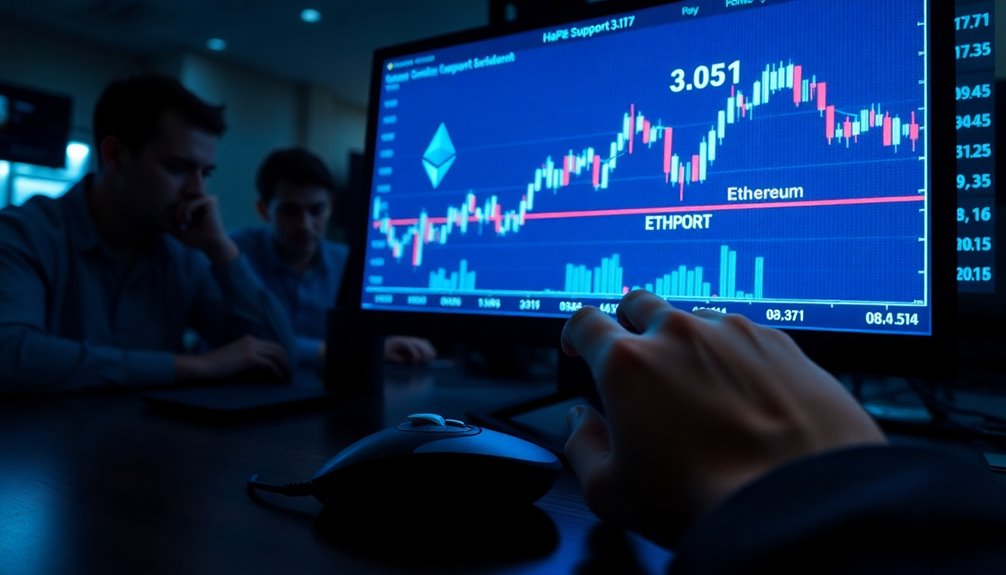Ethereum’s currently facing intense selling pressure right around the $3,051 support level, creating a bearish atmosphere driven by market fear and uncertainty. Retail traders are anxious, leading to sell-offs that further contribute to this downward trend. The recent bearish momentum has traders concerned about potential price drops, especially with declining funding rates. Yet, historical price movements suggest that this support level is crucial for Ethereum’s stability. You might want to explore how institutional investments and strategic risk management could play a role in navigating these turbulent waters. Additionally, while the current sentiment around Ethereum leans heavily towards bearishness, savvy investors may see this as an opportunity to identify undervalued assets. In such turbulent times, the potential for a recovery could be enhanced by a shift in market dynamics, particularly if institutional investments flood back into the sector, driven by a renewed interest in a bull market and underpriced cryptos. As traders reassess their strategies, the focus on long-term value may lead to a stabilization of prices, creating a more favorable environment for Ethereum’s growth in the future.
Key Takeaways
- Ethereum is currently experiencing significant selling pressure around the crucial support level of $3,051.
- Market sentiment is dominated by fear and uncertainty, contributing to retail traders' sell-offs.
- Historical price movements highlight the importance of key support levels like $3,051 for future price actions.
- Declining funding rates suggest traders expect further price drops, intensifying selling pressure.
- The current bearish atmosphere affects buying interest, crucial for Ethereum's price stability.
Ethereum Fundamentals Overview

As Ethereum continues to evolve, it remains a focal point in the crypto landscape, driven by significant developer activity and robust fundamentals.
You'll notice that Ethereum boasts 7,673 full-time developers and over 23,600 monthly active developers, despite a slight decline in full-time developers. In comparison, other projects like Polkadot and Cosmos lag far behind. Additionally, 7,625 out of 39,148 blockchain developers prefer Solana, showcasing the competitive landscape in developer engagement.
The Base network also shows impressive growth, with a 52% annual increase in developer activity.
Furthermore, Ethereum's developer engagement is evident, with over 180,000 DevActivity events recorded. This level of participation indicates a strong commitment to the network's ongoing development.
Market Sentiment and Price Dynamics

Ethereum's robust fundamentals may not be enough to shield it from the current market sentiment, which is heavily influenced by fear and uncertainty.
Retail traders, particularly newcomers, are feeling anxious, leading to widespread sell-offs triggered by fear, uncertainty, and doubt (FUD). While these panic-induced sell-offs create opportunities for larger investors to accumulate assets, they also contribute to a bearish atmosphere. You might notice declining funding rates, indicating that many traders expect further price drops. However, a recent bullish spike in funding could signal a potential rebound.
With Ethereum hovering around the crucial $3,051 support level, the market's next moves will depend heavily on buying interest and overall sentiment. Additionally, the current price of Ethereum is approximately $3,396.80(ETH price), reflecting the market's ongoing volatility.
Transaction Validation Process Explained

When a user initiates a transaction on the Ethereum network, the process begins with the creation of a request that gets sent to the Ethereum Virtual Machine (EVM). This transaction is assigned a unique cryptographic hash and broadcasted to the network, entering the mempool as a pending transaction.
A validator is randomly chosen every 12 seconds to propose a new block. They verify the transaction's validity and compile it into a block, which is then proposed for inclusion in the blockchain. Validators must stake 32 ETH to participate in the Proof of Stake consensus mechanism, ensuring economic security and incentivizing honest behavior.
For the block to be accepted, it must receive attestation from two-thirds of the validators. Once confirmed, the transaction is finalized, becoming an immutable part of the Ethereum history, and users can check its status through blockchain explorers.
Pros and Cons of Trading

Trading cryptocurrencies like Ethereum offers both advantages and challenges that can significantly impact your investment strategy.
On the upside, high liquidity allows you to buy and sell quickly, reducing slippage and making short-term trades less risky. You'll benefit from predictable price swings and familiar market trends, which can enhance your trading decisions. Currently, Ethereum faces significant selling pressure amid bearish market trends, which can also affect liquidity. Additionally, understanding technical indicators can help traders anticipate market movements more effectively.
However, the volatility of Ethereum poses a high risk, as significant price swings can lead to substantial losses. Continuous market monitoring can be time-consuming and mentally exhausting.
Additionally, transaction costs can escalate, particularly during peak times, eating into your profits. Ultimately, weighing these pros and cons is crucial for anyone looking to trade Ethereum effectively.
Price Trends vs. Bitcoin

While Ethereum and Bitcoin often dominate discussions in the cryptocurrency market, their price trends can diverge significantly, impacting traders' strategies.
As Bitcoin's price predictions for 2025 suggest a bullish outlook, ranging from $75,550 to $125,000, you might find it essential to track its movements closely. With a consensus among experts aiming even higher, potential targets could reach up to $200,000. Notably, the bullish cup and handle chart pattern indicates potential BTC targets above $150,000.
In contrast, Ethereum's performance near $3,051 support could affect your trading decisions, especially if Bitcoin experiences fluctuations between $93,072 and $114,857.
Keeping an eye on technical indicators and market sentiment is crucial, as they can influence your approach to both assets and help you capitalize on market opportunities effectively.
Market Volatility and Uncertainty

Recent fluctuations in Bitcoin's price highlight the inherent volatility that also affects Ethereum, creating a landscape fraught with uncertainty.
Positive news can boost Ethereum's price, while negative sentiment—like security issues or regulatory crackdowns—can lead to sharp declines. This is especially relevant given the importance of AI security measures in maintaining trust in digital assets.
Speculation plays a crucial role, as investor sentiment, often expressed on social media, can significantly impact returns. This is particularly evident during periods of major technological developments, such as Ethereum 2.0 upgrades, which can lead to increased investor optimism.
Fear and anxiety among investors can exacerbate market swings, heightening volatility.
Additionally, economic and political uncertainties contribute to this unpredictable environment, influencing how you perceive and react to market movements.
As regulations evolve, your confidence in Ethereum's stability may waver, prompting cautious investment decisions.
Staying informed is key to navigating this turbulent landscape effectively.
Recent Institutional Investments

Institutional investments in Ethereum are on the rise, signaling growing confidence in the cryptocurrency's potential.
BlackRock's adoption of blockchain for tokenizing real-world assets, along with Franklin Templeton and UBS's involvement, highlights this trend. As institutions become more familiar with investment strategies, they are increasingly drawn to Ethereum's innovative capabilities.
Ethereum ETFs have seen impressive inflows, hitting $1 billion in November and $2.1 billion in December, with projections reaching $28.5 billion by 2025.
This surge in institutional adoption is likely to continue, especially with a favorable regulatory environment on the horizon.
Given Ethereum's dominant position in the RWA market, capturing 81% of it, the opportunities for substantial fee growth are immense. Ethereum's reliability as a platform for tokenization further solidifies its appeal among institutional investors.
As more institutions recognize Ethereum's capabilities, expect further investment and innovation in this space.
Risk Management Techniques

As Ethereum continues to attract institutional investments, it's vital for investors to implement effective risk management techniques to protect their capital.
First, consider diversification; spreading your investments across various assets can minimize risk and enhance potential returns. Moreover, high volatility in cryptocurrency markets can significantly impact asset prices, making diversification even more critical. Maintaining a diverse portfolio aligns with holistic SEO approaches that emphasize comprehensive strategies for better outcomes.
Next, apply the 1% rule by limiting each trade to no more than 1% of your total capital, keeping potential losses manageable.
Evaluate the risk/reward ratio for each investment, aiming for at least 1:2 to ensure favorable outcomes.
Additionally, set stop-loss and take-profit targets to control losses and lock in profits.
Finally, utilize a Crypto Risk Assessment Matrix to assess the macro criticality and identify high-risk assets, ensuring a comprehensive approach to risk management.
Frequently Asked Questions
What Factors Influence Ethereum's Support and Resistance Levels?
To understand Ethereum's support and resistance levels, consider market sentiment and trading volume.
Weak buying interest can signal bearish trends, while technical analysis tools like moving averages and Fibonacci retracement levels help identify critical price points.
External events and market volatility also play a role, impacting price dynamics.
Lastly, trader psychology around supply and demand influences how you perceive these support and resistance levels, shaping your trading decisions effectively.
How Does Ethereum's Supply Affect Its Price Stability?
Ethereum's supply plays a crucial role in its price stability. Since the merge, you've seen a deflationary trend, with more ETH being burned than issued.
This reduction in supply can lead to price increases when demand is high. Conversely, if demand drops, prices may fall.
You should also consider external factors like market sentiment and regulatory changes, as they can also significantly impact Ethereum's supply dynamics and overall price stability.
What Role Do Gas Fees Play in Ethereum Trading?
You might think gas fees are just a minor detail, but they significantly impact Ethereum trading.
High gas fees can deter you from executing trades during busy periods, while lower fees encourage more transactions.
By using layer 2 solutions, you can cut costs and speed up trades.
Plus, tracking gas prices helps you optimize your transactions, ensuring you pay the least amount possible while maximizing your trading efficiency.
Are There Upcoming Upgrades That Might Impact Ethereum's Price?
Yes, there are exciting upcoming upgrades that could impact Ethereum's price. EIP-3074 allows you to bundle transactions, lowering gas fees and boosting user adoption.
The Pectra upgrade further reduces transaction costs significantly and enhances scalability.
With the Dencun upgrade, blob space will improve Layer 2 solutions, making transactions more efficient.
Each of these upgrades aims to enhance usability, potentially stabilizing and increasing Ethereum's price in the market.
How Can I Securely Store My Ethereum Assets?
Imagine your Ethereum assets as precious jewels; you wouldn't leave them unguarded.
To securely store your Ethereum, consider using a hardware wallet like the Ledger Nano X, which keeps your private keys offline, shielding them from hackers.
Alternatively, software wallets like MetaMask offer user-friendly access but require strong security practices.
Don't overlook paper wallets for long-term storage, but ensure you protect them from physical loss.
Always enable two-factor authentication for an added layer of security.
Conclusion
As Ethereum hovers near the $3,051 support level, you're witnessing a clash of optimism and caution. On one hand, institutional investments signal confidence, while on the other, market volatility casts a shadow of uncertainty. You can either ride the wave of potential gains or tread carefully amid the selling pressure. Balancing risk management with the allure of trading opportunities is crucial. In this dynamic landscape, your choices will shape your journey through Ethereum's evolving narrative.









